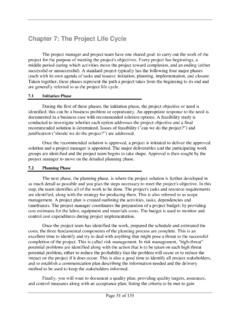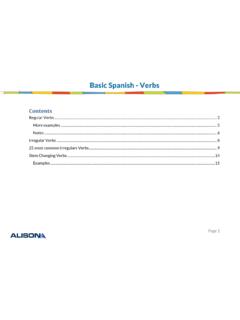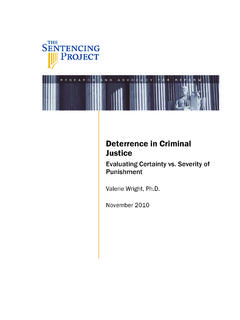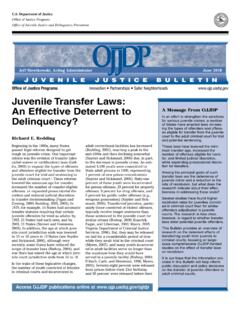Transcription of 1.3 Classifications of law - Alison
1 Classifications of law We have seen that law covers a wide variety of matters and plays a significant role in society. We have learnt that our legal system is made up of both a criminal justice system and a civil justice system. These two systems exist to deal with two different types of laws that have different purposes and lead to very different consequences if they are broken. We will now examine the two main types of classification of law. Civil and criminal law One of the most common Classifications and one that is used by many legal systems, is the distinction between civil and criminal law. As civil and criminal law have different purposes, different systems for dealing with them have developed. criminal law is about creating laws for the protection of society as a whole and providing punishment for those who break those laws.
2 criminal law sets out types of behaviour that are forbidden within society and if the behaviour occurs, then punishment will follow. If you commit a crime, you have offended against the state and the state has the right to prosecute you. At the end of a case, if the defendant (the person who is alleged to have broken the law) is found guilty, they will be punished by the state. Civil law is used to settle disputes between individuals (which can include companies and corporations). At the end of a case, the party at fault has to pay compensation or comply with another suitable remedy, such as an injunction. There are a number of differences between criminal and civil law. These differences include the following. The purpose of each is different. criminal cases are brought to maintain law and orderand to protect society.
3 Civil cases are brought to uphold the rights of individuals andto provide redress. The cases take place in different courts. A criminal case is usually brought by the Crown Prosecution Service (CPS) on behalfof the state (or Crown). A civil case is brought by an individual or company orcorporation. The standard of proof is different. criminal cases must be proven beyond reasonabledoubt. Civil cases only have to be proven on the balance of probabilities. The terminology used is different, and the person starting the case is given a differentname by each system. criminal cases are usually brought on behalf of the Crown(state) and civil cases are brought by a claimant, an individual or company the distinction between civil and criminal is quite clear, it does not always capture the whole of the legal system or the types of law that exist.
4 Another classification that is commonly used is that of public law and private law. Public and private law Public law involves the state or government in some way. There are three main types of law that fall into this category. 1. Constitutional law: this controls how the government operates and is used to resolveany disputes over constitutional matters, for example, who is entitled to Administrative law: this controls how Ministers of State and public bodies shouldoperate and make decisions. An important part of administrative law is a type of courtaction known as judicial criminal law: this also comes under the heading of public law because it involves thestate. criminal law is part of public law because a crime is regarded as an actionagainst society and the state as a law concerns the smooth running of society and covers areas such as work, business dealings, education and everyday life.
5 There are many different areas of law that fall under the heading of private law. Examples include employment law, the law of tort and the law of succession. Using the knowledge gained from your studies so far you will now try to identify what laws may have been broken in the following family example. Activity 1: The classification of law 0 hours 20 minutes Read the information in the box below and, looking back over Section 2, answer the questions that follow. Catherine's day Catherine Taylor drives to work every day. One morning she is late for work and drives at 40 mph in a 30 mph speed limit. At work in the superstore, she has to deal with a number of customer complaints. One of those complaints is from a customer who bought a washing machine a few days ago. It was plumbed in by employees of the store, which is standard practice.
6 However, the first time the customer used the machine it flooded their kitchen causing damage to the floor and some new kitchen cupboards. What laws may have been broken? What rights and responsibilities can be identified?Discussion When Catherine drives at 40 mph in a 30 mph zone, she is speeding (and liable to have points put on her driving licence and a fine if found guilty of the offence). Speeding is a criminal law offence. Laws on speeding are created to provide a safe environment for both road users and pedestrians. One of the reasons why speeding is punished is deterrence , to prevent people from breaking the speed limit and causing road traffic accidents. When Catherine deals with the complaint about the washing machine she is dealing with a civil law matter. On selling the machine, the superstore entered into a contract with the customer.
7 That the machine would work properly was part of that contract. The machine was plumbed in by employees of the store. Again, as part of the contract, the employees should have done this properly and be qualified and trained to do this. As the washing machine has flooded the kitchen there appears to be a fault. As this is a new machine the superstore could be held liable for breaching the contract. If they have breached the contract then they may also be liable for any damage that has resulted from the breakdown of the washing machine. In both these examples rights and responsibilities can be identified. When driving, Catherine has a responsibility to other road users. She should drive in a manner that complies with the law. She also has the right to expect that other road users will drive in a manner that complies with the law.
8 The superstore, when selling the washing machine, has the responsibility to ensure that the machine matches the description they gave and that it works properly. The customer has a right to expect the machine to work properly. They can complain when the machine doesn't work and seek a remedy, such as a replacement machine or the repair of the machine. End of discussion











